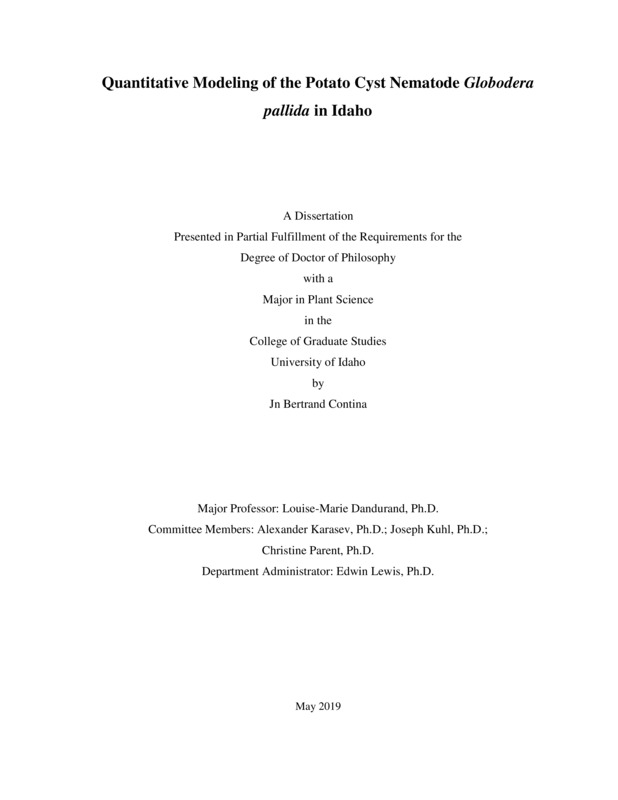Quantitative Modeling of the Potato Cyst Nematode Globodera pallida in Idaho
Contina, Jn Bertrand. (2019-05). Quantitative Modeling of the Potato Cyst Nematode Globodera pallida in Idaho. Theses and Dissertations Collection, University of Idaho Library Digital Collections. https://www.lib.uidaho.edu/digital/etd/items/contina_idaho_0089e_11551.html
- Title:
- Quantitative Modeling of the Potato Cyst Nematode Globodera pallida in Idaho
- Author:
- Contina, Jn Bertrand
- ORCID:
- 0000-0003-1973-5528
- Date:
- 2019-05
- Embargo Remove Date:
- 2020-01-08
- Keywords:
- Globodera pallida Potato cyst nematode Quarantine pest Solanum tuberosum Spatial analysis SUBSTOR-DSSAT
- Program:
- Plant, Soil and Entomological Sciences
- Subject Category:
- Plant pathology; Epidemiology; Agriculture
- Abstract:
-
The potato cyst nematode Globodera pallida is a globally regulated potato pest. It was detected for the first time in the U.S. in the state of Idaho in 2006, and as of February 2019, the infestation is limited to 1,326 ha. Globodera pallida is a specialized obligate sedentary endoparasite that can survive in the soil for up to 30 years in the absence of its potato host. In highly infested fields, the nematode can reduce tuber yields up to 80% and is spread mainly through soil, tubers or farm equipment. The objectives of this study were to: (i) describe the regional spatial arrangement of fields infested with G. pallida in southeastern Idaho; (ii) describe the spatiotemporal distribution of G. pallida in infested fields and the dispersal patterns of the nematode; (iii) determine the effect of the Idaho population of G. pallida on potato yield based on greenhouse assays; and (iv) simulate potato yield losses in Idaho field conditions by integrating the coefficients of potato yield into the SUBSTOR-DSSAT crop simulation model. For Idaho, the regional distribution patterns of fields infested with G. pallida was spatially-aggregated, and the spread of this nematode grew in diameter from the original center of infestation toward the southwest as an ellipsoidal-shaped cluster. In this area, the infestation of the nematode is spatially-clustered particularly around the edges of the fields, and the dispersal patterns of G. pallida followed the direction of cultivation. The prevalence of cysts declined in a non-linear process as the distance separation from the primary infestation focus increased. A power-law model was used to fit the nematode dispersal capabilities. Under greenhouse conditions, fresh tuber weight was reduced between 39% and 87% at G. pallida initial nematode density of 80 eggs/g soil. SUBSTOR-DSSAT model predicted a minimum yield between 12 and 58 ton/ha when initial nematode density was 80 eggs/g soil compared to 96 ton/ha in non-infested soil. The main goals of this study is to first provide information on the spatial pattern of the Idaho G. pallida infestation, and secondly, determine the impact of the Idaho population of G. pallida on potato yield to policymakers, stakeholders, potato growers and researchers to facilitate common understandings on the challenges and opportunities for controlling this pest in Idaho.
- Description:
- doctoral, Ph.D., Plant, Soil and Entomological Sciences -- University of Idaho - College of Graduate Studies, 2019-05
- Major Professor:
- Dandurand, Louise-Marie C
- Committee:
- Karasev, Alexander V; Kuhl, Joseph C; Parent, Christine E
- Defense Date:
- 2019-05
- Identifier:
- Contina_idaho_0089E_11551
- Type:
- Text
- Format Original:
- Format:
- application/pdf
- Rights:
- In Copyright - Educational Use Permitted. For more information, please contact University of Idaho Library Special Collections and Archives Department at libspec@uidaho.edu.
- Standardized Rights:
- http://rightsstatements.org/vocab/InC-EDU/1.0/

